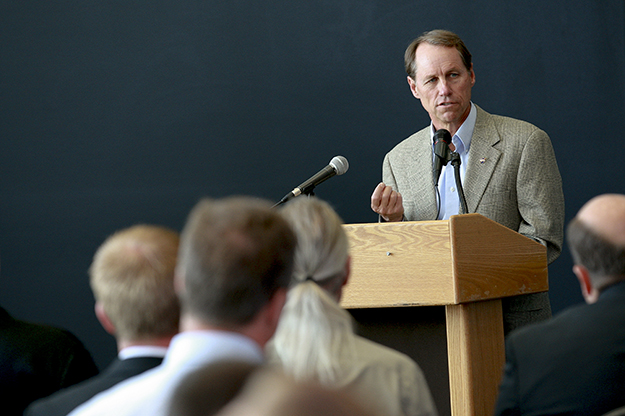The perfect UAS ecosystem
UND plays important roles in Northern Plains UAS Test Site, NASA’s successful integration of drones in populated airspace

Couldn’t have asked for better flying weather: UND student pilots took advantage of those near-ideal conditions last week with close to 300 flights approaching 500 hours.
That weather also encouraged another kind of flying.
Nearby, in farm fields just south of Thompson, NASA and the Northern Plains Unmanned Aircraft System (UAS) Test Site were in full swing testing NASA’s UAS Traffic Management (UTM) system.
The goal: help NASA carry out flight tests as part of its UTM implementation, operation and maintenance, which eventually will facilitate the full and safe integration of unmanned and autonomous aircraft into the National Airspace System.
At a press conference last Tuesday (June 6), Nick Flom, test site executive director, said the UTM test series—and the fact the day’s drone flights didn’t interfere with the safe operation of UND’s other student aviators in the air—reflected the best of North Dakota’s collaborative UAS ecosystem.
“The UAS industry seems to be advancing at the speed of light,” said Flom.
“We really wanted to showcase the collaborations taking place in the state of North Dakota,” Flom said. “The UAS industry is something that we can all get behind. Really what this project does is underscore why we invested in the UAS ecosystem in North Dakota. So we thank NASA for allowing us to take part in the research on the UTM system.”
Public-private partnerships
The NASA UTM system supports a variety of uses, including package deliveries; farmland surveys; powerline/power pole inspections; search and rescue operations; video surveillance operations and runway, railway and bridge inspections.
North Dakota Lt. Gov. Brent Sanford, who chairs the Northern Plains Unmanned Systems Authority, said he was excited about the UTM initiative and the Test Site’s participation.
“It’s just the latest example of the tremendous potential that public-private partnerships bring to our state and to this growing UAS industry,” said Sanford, former mayor of Watford City, N.D. “All the companies involved in this project—SkySkopes, UAII, ISightRPV and Botlink—with NASA are North Dakota-based companies.”
“We remain committed to developing our state into a national hub for UAS research, development and commercialization,” Sanford said.
Flom noted that the Test Site’s involvement with NASA’s UTM testing program began three years ago when UTM was but a concept.
“Fast-forward to April 2016: The Northern Plains Test Site was able to participate in NASA’s first UTM national campaign which tested out the first phase of their development,” Flom said. “By this point UTM was starting to gain a lot of momentum. NASA recognized that was a way forward to combat a problem that we will eventually face with low-altitude traffic management with the number of UAS that will be flying in the National Airspace.”

Impressive ramp-up
NASA’s statement of work on this project laid out the research areas, Flom said. They included flying in beyond-visual-line-of-sight environment; testing sense-and-avoid technologies; engaging with industry partners who had not participated previously within the NASA UTM initiative; flying scenarios that simulated real-world UAS operations including, for example, power line inspections and precision agriculture; and there was a public safety element to the testing.
“I was picturing in my mind exactly who I was going to call to meet all of these requirements: it was easy, all my phone calls were going to start with the 701 (North Dakota) area code,” he said.
Chris Theisen, the test site’s director of research, development, test and evaluation, said it’s an exciting time to work with NASA on the UTM project.
“We have been conducting UAS flights, testing these UTM concepts and technologies and systems throughout this past month, all culminating in the final demonstration flights that were happening this week,” said Theisen, a UND alum and drone pilot. The tests included flying drones over power lines and surveying the land around them, and around farm fields. The test team included UND Aviation, which provided data to the UTM system from a ScanEagle simulator located at UND.
“The ability of the Test Site to ramp up from the award in March was very impressive,” said NASA’s Ron Johnson, lead for integration, evaluation, and transition research focus area and a member of the UTM testing team.

Landowner help
In his closing remarks, Flom thanked farmers Paul Galegher and Chuck Nelson for granting the test site permission to access their land near Thompson to conduct the flight tests. He also acknowledged Xcel Energy’s collaboration in allowing UTM test flights over their power lines.
Grant McGimpsey, UND Vice President for Research & Economic Development and Dean of the School of Graduate Studies, said these types of projects are enhanced by UND’s ability to collaborate actively in the state’s UAS ecosystem.
“UND is very much a pioneer in terms of the research that’s enabling this kind of UTM project,” McGimpsey said. “We laid the ground work for it with both our manned and our UAS research. So I think of UND as the originator of the research that’s led to this relationship with NASA.”


